Tarantula hawks, aka – pepsis wasps, are impressive with bright orange wings on a large velvety black body. They feed on nectar from flowers but are most famous for their battles with tarantulas !! The fearless tarantula hawk female that is ready to reproduce searches for a tarantula burrow…
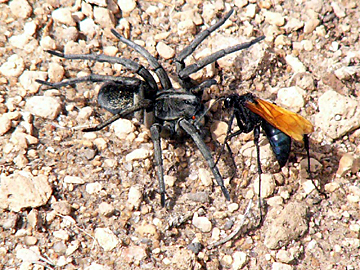
This tenacious pepsis wasp will tap and strum the web at the burrow entrance trying to coax the tarantula out. If the tarantula responds, a long battle will begin!
Most often the tarantula hawk wins by delivering a paralyzing sting to the tarantula. The paralyzed tarantula is dragged to a pre-dug burrow and dropped in by the large female wasp.
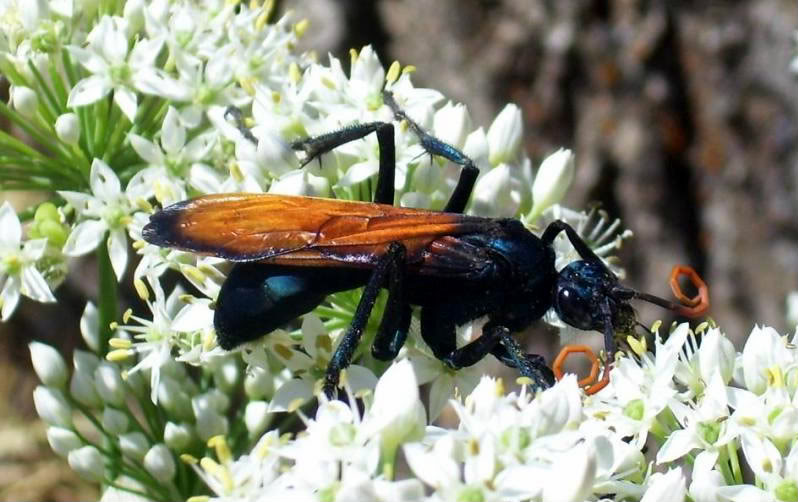
The tarantula hawk then lays a single egg on the paralyzed tarantula and leaves. The wasp larva will hatch and feed on the tarantula spider. After completing its metamorphosis, in about 3 weeks, the adult pepsis wasp will then dig its way out of the underground burrow and start its life cycle anew.
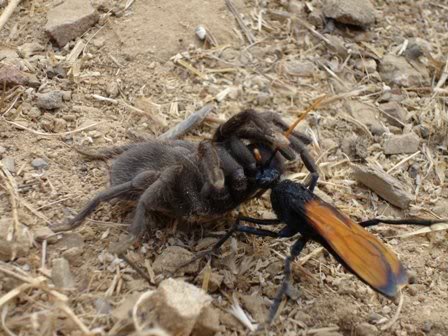
Tarantula Hawks, have the second most painful sting of any insect. Just how painful is the sting of the Tarantula Hawk? The Schmidt Sting Pain Index rates insect stings from 1-4. Africanized bees and hornets register 2. Bullent Ants and Pepsis wasps register 4 !!
Only the female Tarantula Hawk stings because the stinger is derived from the ovipositor, the egg-laying organ.
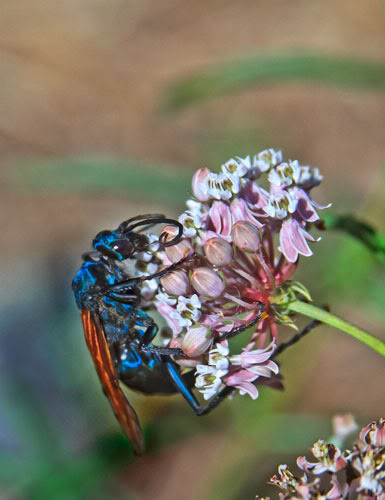
In the deserts of the southwestern US two species of Tarantula Hawks are common, pepsis formosa and pepsis thisbe. The most common in Arizona is pepsis formosa wasp with the orange wings.
Hundreds of Tarantula Hawk Wasp species exist worldwide. The color of the wings may very from species but the sting of the this killer wasp is described as blinding, fierce, and shockingly electric. Simply unbearable pain, lasting 3 minutes. A long 3 minutes! Not lethal to humans unless you are allergic to pepsis wasps.
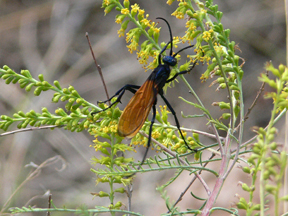
How to tell the difference between the male and female pepsis wasp?
- The antennae of the male tarantula hawk is tightly curved while the FEMALE wasp is only SLIGHTLY curved.
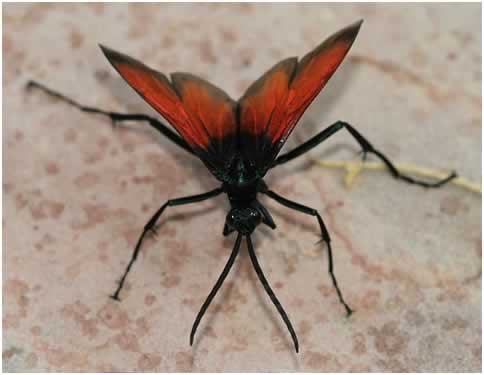
- Tarantula Hawk females grow larger than the males, and can reach up to 3 inches in length.
This youtube video is a battle between the Tarantula Hawk and Tarantula Spider.
Both female and male pepsis wasps are nectarivorous. The male does not hunt but fills himself with the nectar of plants while watching for female tarantula hawks that are ready to reproduce.
Other than Roadrunners and Bullfrogs, most predators avoid the Tarantula Hawk wasp.
Little TIDBIT: The tarantula hawk wasp is the state insect of New Mexico

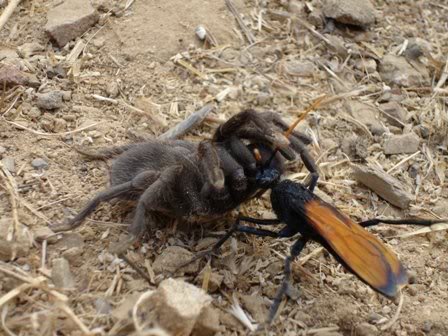
I have spent many years out in the Arizona deserts prospecting, every time I introduce water into the area it seems a lot of insects show up. I figure that to the insects the water is a blessing to them after months of no water in the dry desert.
Without fail several hours of being there, it presents itself. The most interesting thing that happens is that all other insects seem to go away (including the bees) so I welcome their presence. I called it a fairy, it is amazing to watch them. Once the fairy left, the bees and others would return. Now that is some kind of respect and acknowledgement going on.They fly around with no worry, they are not aggressive nor do they display any sign of fear.
I would continue my day of prospecting and allow the fairy to have its way with my area, drinking of the water and whatever it did. I would stand side by side with it. Put out my hand to allow it to land on me. It was simply a beautiful insect in its nature and appearance. Unknown to me, I had no idea the creature I was admiring and interacting with could, if it wanted to, humble me in a matter of seconds and let me know who was in control there.
I never cared to research as to what this insect was, I simply admired it and appreciated it. When I discovered that it was a Tarantula Hawk and what it was capable of, it stood me back for a second, but it does not change how I interact with them it simply confirms the respect that should be given to this insect if you don’t want to be in excruciating , unabating pain for three minutes ( that can be a long time). I know, that from my experience with them, that the Tarantula Hawk will not attack you and sting you unless you deserve it. And as far as I am concerned, if you instigate or abuse this creature and it stings you I hope it lasts 5 minutes.
Don’t be afraid of it.. Do Respect it!
Thank you TJ for this amazing research and introduction to the Tarantula Hawk.
LikeLike
Thank you for sharing your experience, it is good to hear from someone who interacts with them! Let us know the next they visit you; it is quite interesting 😀
best regards,
LikeLike
Aaaargh! Staying away from those little buggers!! Been stung by a hornet and don’t want to try anything else – thank you very much 🙂
LikeLike
I agree with you! Hornets only rank 2 on the pain scale. Tarantula Hawks rank the highest 😀 Thanks for commenting!
LikeLike
Fascinating! 😀
LikeLike
Glad you liked it, thanks for the comment Cathy!
blessings,
LikeLike